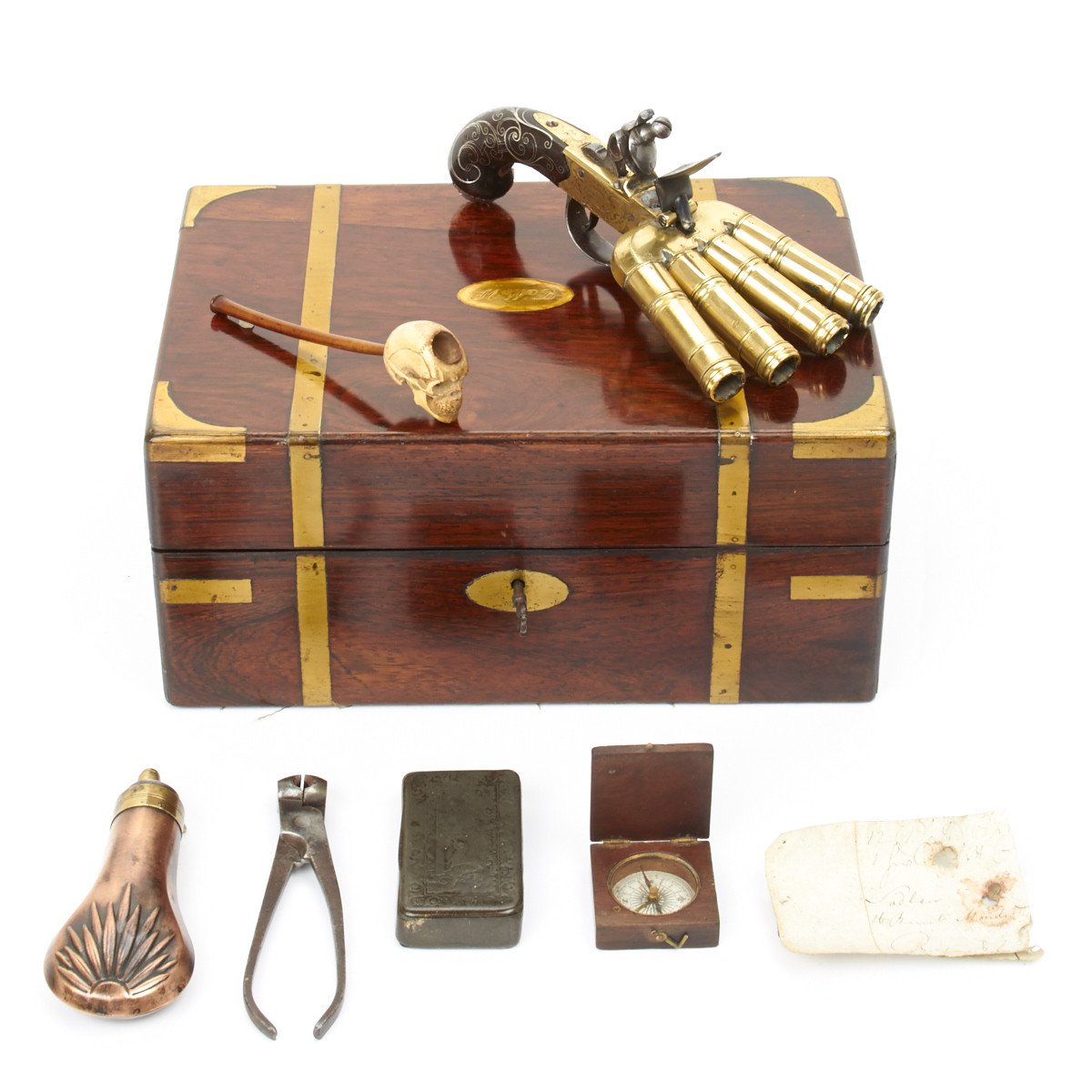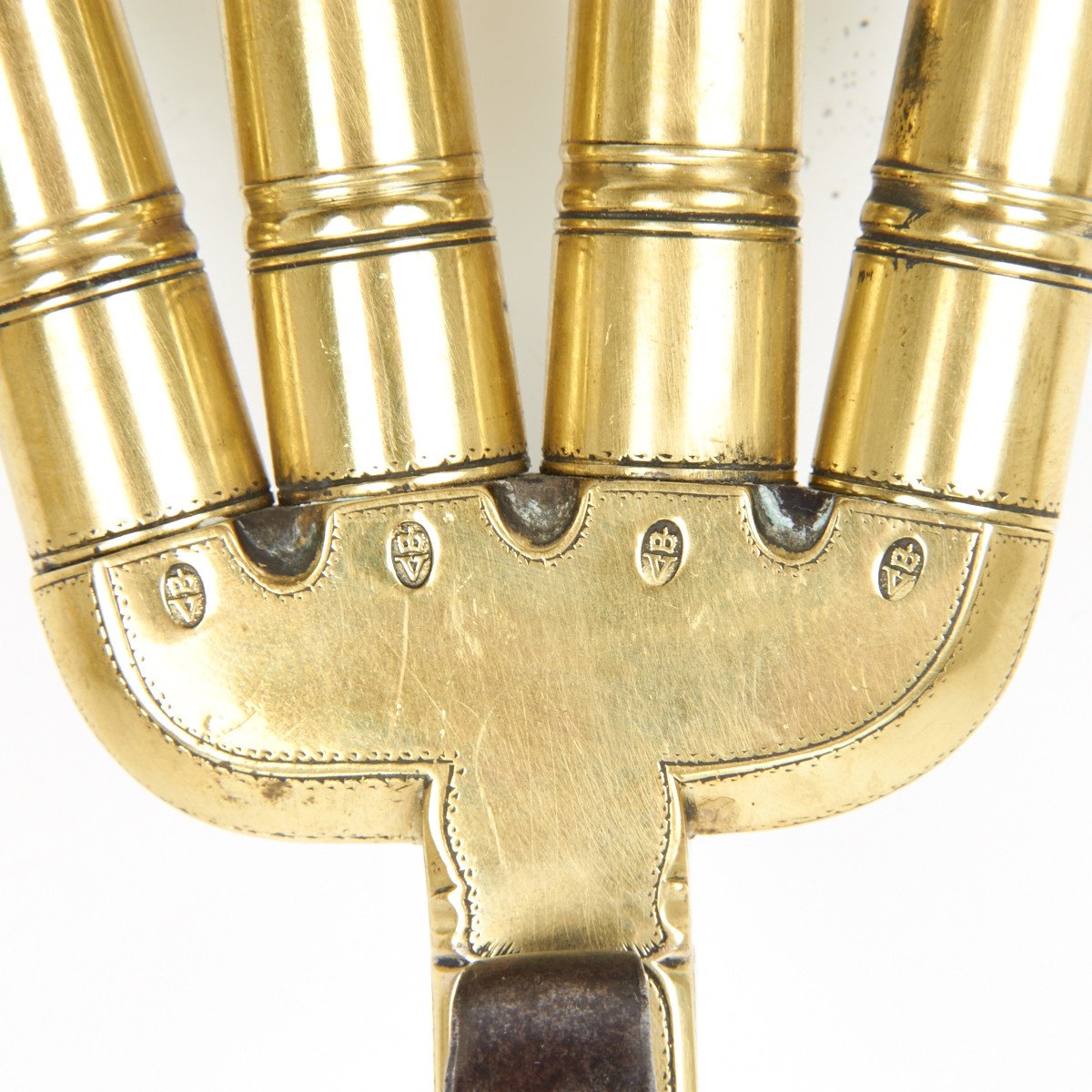Original 1760 British Cased Ducks Foot Flintlock Pistol Set with Bone Skull Pipe inscribed to Henry W Baynton Original Items
$ 27.995,00 $ 6.998,75
Original Items: One-of-a-kind. Only on very seldom occasions to offerings like this come along. Acquired from an old English collection that was sold off by the family after the collector’s passing here is a truly fascinating and rare offering.
A lovely brass framed Flintlock Duck’s Foot Pistol made by “COLLUMBELL of LONDON,” who worked from 1680 to 1743. Four brass barrels, numbered 1-4 and all with “Crown over V” Proof marks. Wood grip beautifully silver wire inlaid with sterling silver masked butt cap. The frame is marked “COLLUM-” over “-BELL” on the right side and “LONDON” on the other. The pan has three touch holes to simultaneously ignite all four barrels. The pistol is contained in the original brass bound mahogany wood case displaying the initials “H.W.B.” to the brass oval in the center of the lid. Interior fully lined in mid blue velvet with evidence of a trade label in the lid long absent.
The Case, 11″ x 8″ x 5″ containing a copper and brass powder flask, an iron bullet mold which lays over a pair of mother of pearl gripped sprung loaded wad cutting scissors each arm of which has a folding knife blade installed, all contained in it’s original leather sheath.
Also included is a tiny wood cased compass, 1.75″ X 1.75″, still working, of the period with a brass hook closure. A decorated pewter lidded container, presumably for snuff, laid in over a scrap of 18th century paper bearing long hand script. The case has a lidded compartment containing some flints and the correct key to the case and finally fitted under the pistol in it’s own custom made slot is a beautiful small Seaman’s pipe with a small wood stem and a bone bowl carved into the shape of a human skull. Most compelling!
The initials “H.W.B.” stand for HENRY WILLIAM BAYTON born 1766, the son of the British Consul General in Algiers in North Africa.
He joined the Navy aged 13 in 1779 and we assume the Set was a gift from his Family, no doubt being his father’s gun acquired for self protection before going on Foreign Service since the pistol is much older than Baynton himself.
Baynton received his Lieutenancy in 1783 and joined Sir John Jervis, later Earl St. Vincent, in the capture of Martinique. He was given command of the Sloop HMS Avenger and was promoted Post Captain of HMS Undaunted in 1794. He remained extremely active in the Caribbean, with several different commands, and finally returned to England in 1804 where he was given command of the H.M.S. LEVIATHAN, 74 Guns. Captain Henry Baynton took part, still commanding H.M.S.LEVIATHAN, in the Battle of Trafalgar on October 21st 1805 being the fifth Man-o-War in Nelson’s weather column.
During the battle Baynton captured the Spanish Ship “SAN AUGUSTIN” and he accepted Commodore Don Fillipe’s Sword in surrender. Due to the great storm which followed the battle many of the “prizes” were deliberately burnt, including the SAN AUGUSTIN, for fear of their falling back into enemy hands.
Subsequently Baynton was a guidon bearer at Admiral Nelson’s state funeral and he received a very prized Lloyd’s Patriotic Fund Sword and many other gifts. He was promoted Rear-Admiral of the Blue in 1812 and after an illustrious Naval career became a full Admiral of the Blue and a Knight Grand Cross of the Order of the Bath in 1839. He finally died on December 16th 1840 aged 74 years.
Fast Shipping with Professional Packaging
Thanks to our longstanding association with UPS FedEx DHL, and other major international carriers, we are able to provide a range of shipping options. Our warehouse staff is expertly trained and will wrap your products according to our exact and precise specifications. Prior to shipping, your goods will be thoroughly examined and securely secured. We ship to thousands clients each day across multiple countries. This shows how we're dedicated to be the largest retailer on the internet. Warehouses and distribution centres can be located throughout Europe as well as the USA.
Note: Orders with more than one item will be assigned a processing date depending on the item.
Before shipping before shipping, we'll conduct a thorough inspection of the items you have ordered. Today, the majority of orders will be delivered within 48 hours. The delivery time will be between 3-7 days.
Returns
The stock is dynamic and we cannot completely manage it because multiple stakeholders are involved, including our factory and warehouse. So the actual stock may alter at any time. It's possible that you may not receive your order once the order has been made.
Our policy is valid for a period of 30 days. If you don't receive the product within 30 days, we are not able to issue a refund or an exchange.
You can only return an item if it is unused and in the same state as the day you received it. You must have the item in its original packaging.
Related products
Uncategorized
Uncategorized
Uncategorized
Uncategorized
Uncategorized
Uncategorized
Uncategorized
Uncategorized
Uncategorized
Uncategorized
Uncategorized
Uncategorized
Uncategorized
Uncategorized
Uncategorized
Uncategorized
Uncategorized
Band of Brothers ORIGINAL GERMAN WWII Le. F.H. 18 10.5cm ARTILLERY PIECE Original Items
Uncategorized
Armored Burgonet Helmet & Polearm from Scottish Castle Leith Hall Circa 1700 Original Items













































































